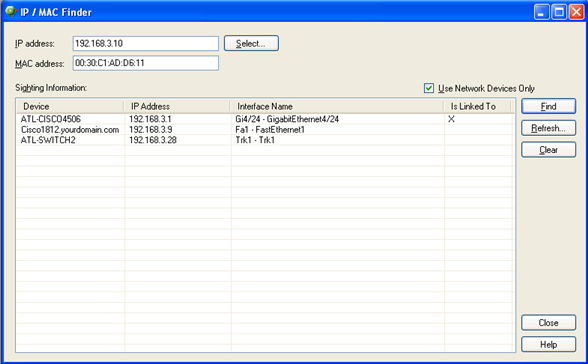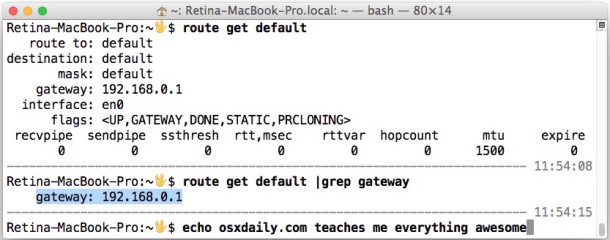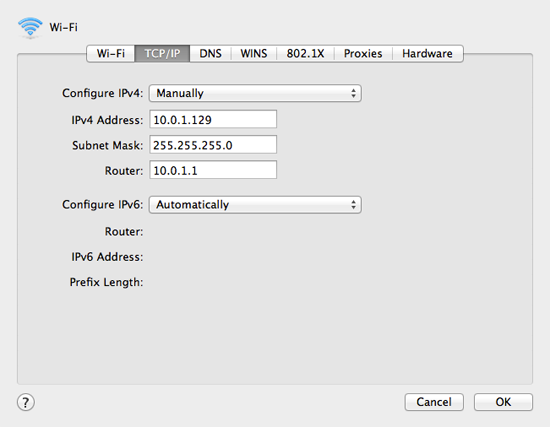By Adela D. Louie, Last updated: August 27, 2019
Ever wonder what IP address is? Do you know how you can find them on your Mac? Well if you are actually asking yourself “how to find my IP address on Mac”, then this article is for you.

Oct 28, 2019 Finding the IP from a known MAC address should be the task of a ReverseARP application, the counterpart of ARP. But RARP is an obsolete protocol with many disadvantages, so it was quickly replaced by other protocols like BOOTP and DHCP, which deal directly with IP addresses. After taking down the mac address from the local switch using show mac-address-table command, log on to nearby router or L3 switch and issue the show arp to get the IP address. I hope you must be able to find the IP address from the router as the device connected to F0/7 of switch has to comminicate over the router at some point of time. I have ip address of one of my remote server I cannot login remotely. I have the IP address and I and trying to find the mac address or interface that connected to the server. Could you tell me the command or the way to find the Switch port or mac address if you only have ip address. See full list on wikihow.com.
Once that your Mac is connected to a network, then that will automatically be addressed on a network that is called the IP address. The IP Address is a set of four digits that are actually separated by periods. Each set is composed of three digits. And once that your Mac is connected to a certain network which includes the internet, that it will automatically have an internal IP address which allows it to mark on the certain location on the local network and also an external IP address which refers to the IP address of your internet network.
Part 1: Why is it Important to Know the IP Adress?
Getting to know your Mac’s IP address can actually come in handy especially if you are setting up a network or if you are going to share some files. That is why we are going to show you some ways on how you can find the both your external and internal IP address that you have on your Mac.
Every single device that we have that has the capability of connecting to the internet has its very own Internet Protocol or IP Address. This way, you will be able to find one computer among the different networks.
Part 2: Two Types of IP Address
There are actually two types of IP Address. One is the private IP address and the public IP address. The private IP address is known to be a part of the reusable pool that is set aside by the Internet Engineering Task Force for the individual network. These actually includes an address that begins with “10.”, “172.16.', and “192.168.”. These IP address that we have shown are only relevant to your corporate or to your local network.
And for you to be able to get in touch with other people, the IP address is needed and that your PC should be needing one public IP address. The IP address is considered to be globally unique for it to ensure that this is different from other devices.
Part 3: How to Find IP Address on Mac
So, with all the things being said, then it is time for us to show you on how you can find the IP address. There are actually many ways on how you can find your IP address and we are going to show you on how to do so.
Method #1: Finding Your Internal IP – OS X 10.5 and Newer Version
Step 1: Go ahead and click on the Apple icon located at the upper-left corner of the screen.
Step 2: After that, go ahead and scroll down and choose “System Preferences”.
Step 3: After that, go ahead and click on “Network” located on the third row of the icons shown on your screen.
Step 4: After that, go ahead and choose your connection. Usually, you will be able to be connected to a certain network using your AirPort which is the wireless one, or using your Ethernet which is the wired connection. You will be able to see there on your screen the word “Connected” beside it. And then, you will be able to see your IP address listed beneath you connection status.
Method #2: Finding your Internal IP – for OS X 10.4
Step 1: Go ahead and click on the Apple icon that is located at the upper left corner of your screen.
Step 2: And then, go ahead and look for System Preferences and select it.
Step 3: After that, go ahead and click on the “Network” icon located on the third row from the list.
Step 4: After that, go ahead and choose on your connection. From here, you will be able to choose the connection that you would want the IP address for from the Show drop-down menu. In case that you have a wired connection, all you need to do is to choose “Built-in Ethernet”. And if you are using a wireless connection, go ahead and select “AirPort”.
Step 5: And then, go ahead and click on the TCP/IP tab. From there, you will be able to see the IP address of your Mac.
Method #3: Finding Your Internal IP Address Via Terminal
Step 1: Go ahead and open the Terminal on Mac. You can find this from the utility section from the Application folder.
Step 2: After that, go ahead and enter the ifconfig command on Terminal. This way, you will be able to remove all the unnecessary things and that you will be able to show your IP address on your Mac. All you have to do is to enter this command.
ipconfig | grep “inet” | grep -v 127.0.0.1[2]
Once that you have this command on Terminal, it will automatically remove the “127.0.0.1” that will always appear on whatever device that you are using. This is called the feedback loop. You can ignore this if you are looking for your IP address.
How To Find Your IP Address And MAC Address | PCWorld
Step 3: After that, go ahead and copy your IP address shown on your screen. Your IP address is the one beside the word “inet”.
Method #4: How to Find your External IP Address
Step 1: The first thing that you should do is to open your router’s configuration page. Keep in mind that all of the routers can be accessed using a web interface where you will be able to adjust your settings. All you have to do is to enter your router’s IP address on your browser. You can check on your router’s paper for its specific address. The most common ones are the following:
- 192.168.1.1
- 192.168.0.1
- 192.168.2.1
Step 2: After that, go ahead and launch your router status. Keep in mind that the location of the external IP address will depend from router to router. Most of them have it listed in the Router Status or on its WAN
Step 3: And finally, go ahead and Google search “IP Address”. The very first result that will appear on your screen will be your external or your public IP address.
So, there you have it. These are the ways on how you can look for both your public and private IP Address on your Mac. You can use this for sharing your files and more.
People Also Read17 methods to fix your Mac running slowTop 5 Ways to Fix Update iMessage On Mac Not Working?
Part 4: Getting Your Mac Cleaned
Now that you have already know how you to find the IP address on your Mac, perhaps you are going to use it for you to share some files on your Mac with another person. Now, since that you are going to share files, you have to also consider the fact that your Mac’s storage space may run out. This is why it is better that you remove all the junks that you have in it.
There are actually a lot of ways on how you can clean up your Mac, but there is only one best way to do so. And this is by using the FoneDog PowerMyMac.


The FoneDog PowerMyMac is a tool that you can use for you to be able to clean up all the junk files that you have on your Mac. This way, you will be able to free up more of your storage space and as well as this will actually make your Mac faster.
The FoneDog PowerMyMac is considered to be as one of the best tools that you can for you to maintain your Mac. This is because the FoneDog PowerMyMac is an All-in-One Mac application. This tool can turn into something that you want it to be. It does not only come as a typical Mac Cleaner but it can also become an App uninstaller, performance monitor, a secret keeper, a file unarchive and a Wi-Fi sprite as well. All of that in just one tool.
Now, for you to know on how you can clean up all the junks that you have on your Mac, here is a simple and easy guide for you to follow.

Step 1: Download and Install
Go ahead and have the FoneDog PowerMyMac download from our official website. And once that you have downloaded it, go ahead and install it on your Mac.
Step 2: Launch the FoneDog PowerMyMac
Find Your IP Address On A Mac - OS X Daily
Once that you have successfully installed the program on your Mac, go ahead and launch it. Now, go ahead and click on the “Status” option located at the top of the main interface of the FoneDog PowerMyMac.
From there, you will be able to see your Mac’s system status. You will be able to see their your CPU status, your available memory, and your hard disk of your Mac.
Step 3: Choose A Module
After that, go ahead and click on the “Cleaner” option from the top of your screen. Then the FoneDog PowerMyMac will show you all the modules that the PowerMyMac can do as a Mac cleaner. From the list of modules shown on your screen, go ahead and choose “System Junk”.
Step 4: Scan Your Mac’s System Junk
Then after that, go ahead and click on the “Scan” button. This way, the FoneDog PowerMyMac will then start for all the junks that you have on your Mac. This includes your system cache, your application cache, system logs, and a lot more. At the left side of your screen, you will be able to see there a circle which refers to the progress of the scanning process.
Step 5: Check Out The Result
Once that the scanning process is complete, go ahead and click on the “View” button. If you wish to have a re-scan of your junk files, then you can do so.
Step 6: Choose the File to Clean
After that, the FoneDog PowerMyMac will then show you a list of folders on your screen. You will be able to see System Cache, Application cache, System Logs, User Logs, and more. From there, go ahead and select the folder that you want to clean. On the right side of your screen, you will be able to see the data that each folder contains.
Step 7: Clean Your Junk
Once that you have chosen the folder that you want to delete, all you have to do now is to click on the “Clean” button. And once that you do, all of the unwanted files will all be gone from your Mac.
NOTE: There will be instances that you will be needing to enter your password to confirm the action.
Step 8: Cleaning Junk Successful
Once that you have confirmed on the cleaning process, then all you have do is to wait until the FoneDog PowerMyMac is done with the cleaning process. Once done, all your junks will then be gone from your Mac.
Part 5: Conclusion

So there you have it! Finding the IP address on your Mac is not as hard as it sounds. All you need to have is the right knowledge on how you can do so. And of course, always remember that there are two kinds of IP address that you have on your Mac. One is your private IP and the other one is your public IP. So depending on what you are looking for, the process may come differently.
And of course, maintaining your Mac is also one of the most important things that you should do. And for you to do so, you will be needing a powerful tool that can help you in so many ways. This is no other than the FoneDog PowerMyMac.
This tool is not only a Mac cleaner, but it can do even more things that other tools cannot do. This is because the FoneDog PowerMyMac is considered to be an all-in-one tool. This tool can help you speed up your Mac and can make your Mac good as if you first bought it.